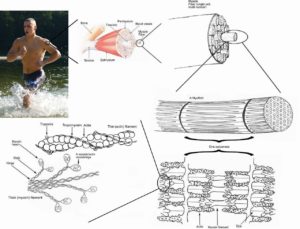 Our bones hold us up and our muscles move us.
Our bones hold us up and our muscles move us.
That is one of my most common refrains and while accurate gives short shrift to the awesomeness of just what muscles can do.
Muscles generate the power we use to accomplish physical tasks both simple and complex.
Some muscles also assist the bones in holding us up (psoas major and piriformis) and muscles also aid in internal functions such as our heartbeat and peristalsis which allows for digestion.
There are three types of muscles- skeletal, smooth, and cardiac.
Skeletal muscles are connected to bones through tendons while smooth muscles exist within internal structures such as the organs, the esophagus, and the bronchi which transport air into the lungs.
Cardiac muscle is only found in the heart.
There is another distinction between the muscle types—striated and smooth.
Skeletal and cardiac muscles fall into the striated category while the smooth muscles are not striated.
Striation refers to the way the individual muscle units called sarcomeres are arranged within the muscle itself.
The sarcomeres of skeletal muscles are arranged in parallel bundles while the fibers of cardiac muscle connect at odd angles creating a difference in contractibility.
Striated muscle will contract and relax quickly and intensely while smooth muscle will contract for much longer periods.
The contractibility of smooth muscles is different due to the different arrangement of the sarcomeres.
Skeletal muscle is considered to be voluntary in that these muscles will react to conscious choice.
I want to move my hand—my hand will move. Smooth muscle works below our level of conscious choice—unless I am an advanced yogi I can’t stop the beating of my heart even if I wanted to.
I try to keep this stuff simple but when you get into muscles it is hard to keep the science out and make it understandable.
For whatever it is worth I have been trying to learn this kind of more advanced anatomy for a while and it often whizzes past my head and fails to stick. But I keep plugging away.
***
